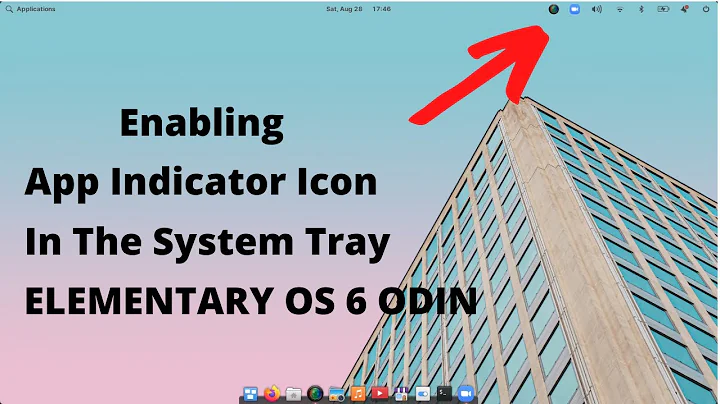How to re-enable the systray (indicator panel) after latest updates
Solution 1
Try using the Indicator Systemtray Unity (for Ubuntu 14.04 - 15.04):

Indicator, when clicked, shows the tray.

Also there is a display mode "separately from the indicator" - on top of the panel like a dock. In this mode, the position can be changed by scrolling the mouse over the indicator. To change the mode position: press the middle mouse button on the indicator.
Installation in the terminal:
sudo apt-add-repository ppa:fixnix/indicator-systemtray-unity
sudo apt-get update
sudo apt-get install indicator-systemtray-unity
You must then log out and again log in using your user.
https://github.com/GGleb/indicator-systemtray-unity
To remove this package (with its configuration files!!!):
sudo apt-get --purge remove indicator-systemtray-unity
Solution 2
In 16.04 (xenial) I managed to display a panel item for
wicd-gtk --tray
by installing
apt-get install python-appindicator
Configuration options are displayed when right-clicking on the icon.
Related videos on Youtube
Comments
-
Paddy Landau over 1 year
After Suttleworth's bizarre decision to hard-code the whitelist for the systray, a developer created a patch to allow people to continue to use applications that use the systray with Ubuntu.
Unfortunately, the patch's creator is now too busy to maintain it. This means that since the latest updates earlier this month, the whitelist no longer works (again).
Canonical's "solution" was to instruct us to raise a bug report for each application that doesn't work, but of course those bug reports have been ignored.
So…
How can I re-enable the systray? Its absence is creating difficulties for me.
I am using Ubuntu 14.04 64-bit.
Answering the question by @GGleb
Command
gsettings list-recursively net.launchpad.indicator.systemtrayResults
net.launchpad.indicator.systemtray disable-indicator false net.launchpad.indicator.systemtray started-the-first-time false net.launchpad.indicator.systemtray static-x 0 net.launchpad.indicator.systemtray static-y 0 net.launchpad.indicator.systemtray tray-is-static falseI notice that
tray-is-statictoggles when I middle-click the icon. -
Paddy Landau about 9 yearsThank you. This is significantly better than nothing, although I wish that we could still use the systray panel. Shuttleworth has no idea of the problems that he has caused.
-
Paddy Landau about 9 yearsFor some reason (I think that you edited your answer), the first time around I missed the bit about the middle mouse button, which I've now tried. Unfortunately, it doesn't work for me. The middle mouse button merely toggles between two modes: The first mode is as you first described. The second mode prevents it from displaying anything when clicked, i.e. it is useless in that mode. Do you have any advice to make the middle button work as yours does? (Synaptic reports the version as 0.1-trusty1.)
-
GGleb about 9 yearsYou can show the output of the command?:
gsettings list-recursively net.launchpad.indicator.systemtray -
Paddy Landau about 9 yearsI have edited my question to provide the answer.
-
GGleb about 9 yearsFixed. You need to update the indicator. Reminder: in this mode, the position can be changed by scrolling the mouse over the indicator. This mode needs improvement.
-
Paddy Landau about 9 yearsThank you, GGleb. It works now. Allowing the scrolling is fun; I'm glad that you told me about it. Your work is much appreciated!
-
Paddy Landau almost 9 yearsThanks, James, but this is a bad idea both for security and for the reason you already gave. @GGleb's solution works perfectly, allowing updates, so I'll stick with it. I recommend that you try it; apart from an extra icon, the "display mode" is nearly indistinguishable from gurqn's solution. There's no ideal solution, but then Shuttleworth did go a bit off the rails on this one.
-
 GC 13 over 8 yearsThank you @GGleb, Is there a way to keep the indicator in expanded form ?
GC 13 over 8 yearsThank you @GGleb, Is there a way to keep the indicator in expanded form ? -
GGleb over 8 years@Raj S, can you describe more? You can also press the middle mouse button to move the indicator on top panel.
-
 GC 13 over 8 years@GGleb, the tray is available as drop-down button. I was looking if it is possible to get all the icons under the drop-down button can be put on the system-tray itself.
GC 13 over 8 years@GGleb, the tray is available as drop-down button. I was looking if it is possible to get all the icons under the drop-down button can be put on the system-tray itself. -
GGleb over 8 yearsAvailable two display modes described above. Additional functionality is difficult to implement because of the limitations of the Unity DE.
-
Alex about 8 yearsFirst I installed using the ppa repository and then I installed from github with make and sudo make install. In both instances when I middle click and go into "static" mode, no systray icons are displayed anywhere. In floating mode, I can see the icons. Help?
-
Paddy Landau almost 8 yearsThanks for the note. I shall try it when I finally upgrade to 16.04.
-
Danatela almost 8 yearsThere is an icon, but it shows only network information. Your instruction is slightly incomplete.
-
dzmanto almost 8 years@Danatela: Try and right-click on the icon. This produces a lot of configuration options.




![Enable or Disable Windows Update Status Taskbar Notification Area Icon in Windows 10 [Tutorial]](https://i.ytimg.com/vi/EoJ7kAahKIU/hq720.jpg?sqp=-oaymwEcCNAFEJQDSFXyq4qpAw4IARUAAIhCGAFwAcABBg==&rs=AOn4CLBflxGyJjkPavuqFC8Z4IRct1uD_w)

